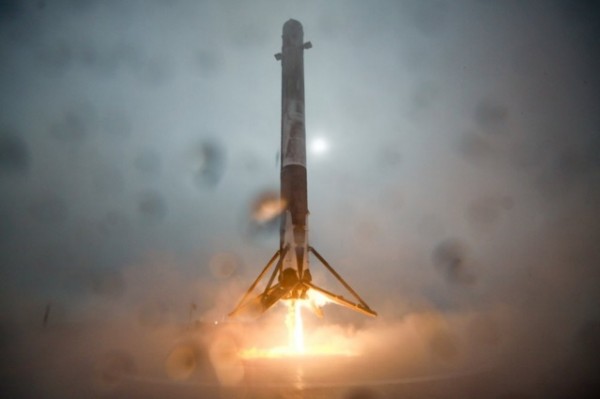By Ana Verayo, | January 18, 2016

Falcon 9 rocket approaches landing target on floating ship, but tips over moments after.
On Sunday, SpaceX's Falcon 9 rocket blasted off from California, launching a climate monitoring satellite into lower Earth orbit, however, this resulted in a failed attempt to land the rocket back safely on a floating platform off the Pacific ocean.
Like Us on Facebook
Falcon 9's rocket made it in one piece onto the droneship, floating across the ocean, however, moments before landing back, one of the rocket's legs failed to hold onto position, reveals CEO and founder of SpaceX, Elon Musk on Twitter. Basically, the rocket tipped over after landing he adds.
The rocket measuring 22 storeys high lifted off from the Vandenberg Air Force Base off the California coast at 10:42 A.M. local time.
This is not the first time that SpaceX attempted a vertical rocket landing after a launch mission where the Falcon 9 successfully conducted a milestone ground landing last month in Florida. This ocean rocket landing would have been a crucial step for Musk's vision to develop and use a cheaper, reusable rocket for future missions especially to Mars.
Apart from this, there were two failed landing attempts last year resulting in rocket explosions. The reason why conducting a successful sea landing is so crucial is that this can allow SpaceX more flexibility to recover rockets on more elaborate missions such as launching heavier satellites where boosters will not have much fuel left for landing on the ground.
Even if the rocket tipped over, rendering a failed landing, this SpaceX launch successfully completed its main mission of launching the Jason-3 satellite some 830 miles above the Earth's surface, in lower orbit. This special climate monitoring spacecraft weighs 1,200 pounds and is the fourth one to be launched to track the world's oceans, observing changes regarding the planet's climate.
According to NOAA (National Oceanic and Atmospheric Administration) lead scientist for the Jason-3 mission, Laury Miller, 90 percent of heat that is trapped inside the Earth's atmosphere and ecosystems are apparently all transferring into the ocean. The ocean is now considered as one of the key players in climate change.
The satellite is designed to work as it bounces off radio waves from the ocean and record how long will it take for the reflected signals to return to the mothership. According to Josh Willis of NASA's Jet Propulsion Laboratory, scientists can then use this data to measure ocean levels within 0.2 inches.
Willis says that this is one of the most important measuring tools for human caused climate change, as factors like heat including runoff water from melting ice sheets can cause ocean levels to soar. Jason-3 can also monitor other weather events like the El Nino phenomenon, tsunamis and even oil spills.
Apart from NOAA, there are four other agencies collaborating with the five year mission of the Jason-3 program, worth US $180 million.
-
Use of Coronavirus Pandemic Drones Raises Privacy Concerns: Drones Spread Fear, Local Officials Say

-
Coronavirus Hampers The Delivery Of Lockheed Martin F-35 Stealth Fighters For 2020

-
Instagram Speeds Up Plans to Add Account Memorialization Feature Due to COVID-19 Deaths

-
NASA: Perseverance Plans to Bring 'Mars Rock' to Earth in 2031

-
600 Dead And 3,000 In The Hospital as Iranians Believed Drinking High-Concentrations of Alcohol Can Cure The Coronavirus

-
600 Dead And 3,000 In The Hospital as Iranians Believed Drinking High-Concentrations of Alcohol Can Cure The Coronavirus

-
COVID-19: Doctors, Nurses Use Virtual Reality to Learn New Skills in Treating Coronavirus Patients







